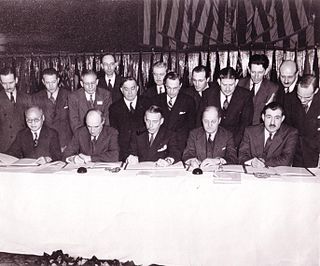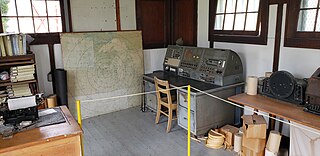
The Federal Aviation Administration (FAA) is a U.S. federal government agency within the U.S. Department of Transportation which regulates civil aviation in the United States and surrounding international waters. Its powers include air traffic control, certification of personnel and aircraft, setting standards for airports, and protection of U.S. assets during the launch or re-entry of commercial space vehicles, powers over neighboring international waters were delegated to the FAA by authority of the International Civil Aviation Organization.

Air traffic control (ATC) is a service provided by ground-based air traffic controllers (people) who direct aircraft on the ground and through a given section of controlled airspace, and can provide advisory services to aircraft in non-controlled airspace. The primary purpose of ATC worldwide is to prevent collisions, organise and expedite the flow of traffic in the air, and provide information and other support for pilots.

Air traffic control specialists, abbreviated ATCs, are personnel responsible for the safe, orderly, and expeditious flow of air traffic in the global air traffic control system. Usually stationed in air traffic control centers and control towers on the ground, they monitor the position, speed, and altitude of aircraft in their assigned airspace visually and by radar, and give directions to the pilots by radio. The position of air traffic controller is one that requires highly specialized knowledge, skills, and abilities. Controllers apply separation rules to keep aircraft at a safe distance from each other and within proper airspace in their area of responsibility and move all aircraft safely and efficiently through their assigned sector of airspace, as well as on the ground. Because controllers have an incredibly large responsibility while on duty and make countless real-time decisions on a daily basis, the ATC profession is consistently regarded around the world as one of the most mentally challenging careers, and can be notoriously stressful depending on many variables. Many controllers, however, cite high salaries, and a large, unique, and privileged degree of autonomy as major advantages of their jobs.

In most countries one is required to obtain a glider pilot license (GPL) or certificate before acting as pilot of a glider. The requirements vary from country to country.

The Civil Aviation Authority (CAA) is the statutory corporation which oversees and regulates all aspects of civil aviation in the United Kingdom. Its areas of responsibility include:

A private pilot licence (PPL) or private pilot certificate is a type of pilot licence that allows the holder to act as pilot in command of an aircraft privately. The basic licence requirements are determined by the International Civil Aviation Organization (ICAO), but implementation varies from country to country. According to ICAO, an applicant must be at least 17 years old, demonstrate appropriate knowledge and skill, and hold at least a Class 3 medical certificate. Different PPLs are available for different categories of aircraft, such as aeroplane, helicopter, airship, etc., and are not interchangeable, although experience from a PPL in one category may be credited towards the issue of another.
The airline transport pilot license (ATPL), or in the United States of America, an airline transport pilot (ATP) certificate, is the highest level of aircraft pilot certificate.

The Convention on International Civil Aviation, also known as the Chicago Convention, established the International Civil Aviation Organization (ICAO), a specialized agency of the United Nations charged with coordinating international air travel. The Convention establishes rules of airspace, aircraft registration and safety, security, and sustainability, and details the rights of the signatories in relation to air travel. The convention also contains provisions pertaining to taxation.

Virtual Air Traffic Simulation Network (VATSIM) is a nonprofit organization that operates an online flight-simulation network noted for its active membership and realism. Users are able to fly aircraft as a pilot, or direct traffic as an air traffic controller in what has been described as a close approximation of real-life aviation procedures.
Pilot licensing or certification refers to permits for operating aircraft. Flight crew licences are issued by the civil aviation authority of each country, which must establish that the holder has met minimum knowledge and experience before issuing licences. The licence, along with the required class or type rating, allows a pilot to fly aircraft registered in the licence issuing state.
Pilot licensing in the United Kingdom is regulated by the Civil Aviation Authority (CAA).

A flight service station (FSS) is an air traffic facility that provides information and services to aircraft pilots before, during, and after flights, but unlike air traffic control (ATC), is not responsible for giving instructions or clearances or providing separation. They do, however, relay clearances from ATC for departure or approaches. The people who communicate with pilots from an FSS are referred to as flight service specialists.

Leicester Airport is an aerodrome located to the east of Stoughton, Leicestershire, England, about 5 nautical miles east of Leicester City Centre by road. The Leicestershire Aero Club Limited, the airport operator, provide elementary flight training, experience flights and the airport is home to a wide variety of private aircraft. The airfield was constructed in 1942 as part of the former RAF station, RAF Leicester East. The facility was named Stoughton Aerodrome prior to 1974.
A flight information service (FIS) is a form of air traffic service which is available to any aircraft within a flight information region (FIR), as agreed internationally by ICAO.

London Elstree Aerodrome is an operational general aviation aerodrome located in Elstree, and is situated 2.6 nautical miles east of Watford, Hertfordshire, England.
Controller–pilot data link communications (CPDLC), also referred to as controller pilot data link (CPDL), is a method by which air traffic controllers can communicate with pilots over a datalink system.
The Guild of Air Traffic Control Officers (GATCO) is a guild of air traffic controllers which began organising in 1952 and was established in 1954. In 2004, it had over 2000 members spread over 125 locations in the UK and overseas in both civilian and military sectors.

General aviation in the United Kingdom encompasses a variety of commercial and non-commercial aviation activities.
The National Private Pilot Licence (NPPL) is a licence to fly United Kingdom registered aircraft within the United Kingdom. It is a more basic licence than the private pilot licence (PPL), and cannot be used to fly all aircraft. It can be used to fly basic aircraft such as vintage aircraft or kit-built aircraft. To fly many basic aircraft such as the Cessna 172, it is necessary to upgrade to at minimum a light aircraft pilot licence (LAPL).

Regulation of unmanned aerial vehicles (UAVs) involves setting safety requirements, outlining regulations for the safe flying of drones, and enforcing action against errant users.













